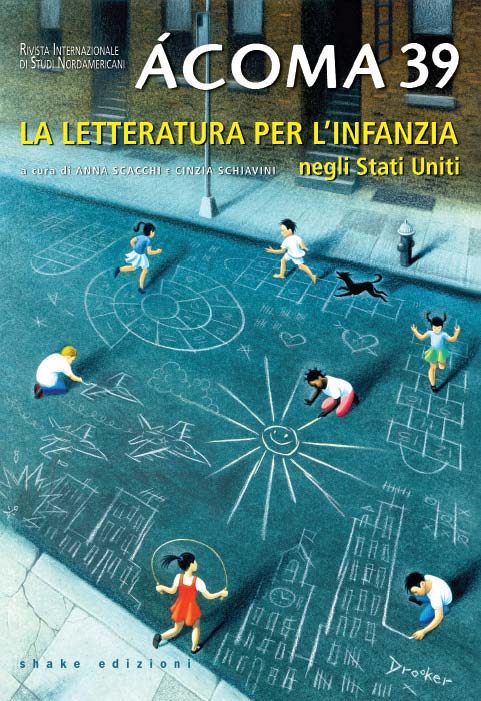Tu sei qui
La letteratura per l'infanzia negli Stati Uniti
Numero 39
Primavera 2010 - Anno XVII
No Country for Old Men: bambini, nazione e letteratura - pp. 7-14
La kiddie lit nell'Accademia - pp. 15-40
The essay investigates the status of children's literature in the United States from the 1850s onward. In particular, the author argues that young readers were included in, and then suddenly excluded from, literary discourse as the arbiters of culture shifted from the editorial boards of famous journals (such as the "Atlantic Monthly") to Acade-mia at the end of the XIX century. Moreover, Clark outlines the pivotal role of public libraries and librarians in the revaluation of childhood and children's literature as a cultural and educational priority.
La "mislettura" dei bambini e il destino dei libri per l'infanzia ~ pp. 41-54
This essay focuses on the socialization of children, reading practices, children's books, and other cultural artifacts and how young people from about three to eighteen are exposed to them. The concern is not about books, how many are read, and whether children learn to read, but how and why they are taught and prompted to mis-read, and by consequence, how and why we continue to mis-read problematic aspects of contemporary culture. By mis-reading, which is non-reflective reading, geared toward quick absorption of information and signs not elaborated by the brain, the author means that we do not carefully examine all the complex institutional processes that bear upon our reading and our personal and public decisions and commitments and that we do not recognize that the rational and efficient operations in the socio-economic system that affect us and our children's lives lead to exploitative and reified relations among all people.
Non soltanto Dick e Jane: la letteratura per bambini negli Stati Uniti e la linea del colore - pp. 55-69
In the 1960s United States the fight for racial integration called for a revision of school curricula as well as textbooks and tradebooks, which resulted in an epochal change in the "all-white" world of children's literature. Thanks to supporting policies from the federal government and the interest of publishers in the new market, children's writers and illustrators were able to publish books which portrayed American multicultural diversity, dealt straightforwardly with the racial question and revised national history from the point of view of minorities.
Piccole donne crescono: gender e letteratura per l'infanzia - pp. 70-86
Books for girls have enjoyed great popularity in the United Stated since the 1860s. However, as a subgenre of children's literature, they have only recently started to be considered worthy of critical study. The different levels of marginalization that have been recognized in the appraisal of children's literature in academia are complicated by the overlapping categories of gender and age in the case of girls' book. The changing fortunes of Little Women, and its author's subsequent fluctuations in and out of the canon, provide an illustration of the prejudices and contradictions that have influenced the critical fate of literature for girls.
"Let's have a pachanga!": comunità e rappresentazione nei libri per l'infanzia chicana - pp. 87-100
This essay examines some key aspects of Chicano/a children's literature: the questions of addressing and representing cross-cultural subjects; the issues of intercultural education, bilingualism and language politics; the attempt to write along psycho-social and pedagogical trajectories of validation of difference; the need to promote integration and school success; the implications of the multiple crosswriting strategies present in Chicano/a children's books. The essay discusses works by Pat Mora, Gary Soto, Juan Felipe Herrera, Amada Irma Perez, and Gloria Anzaldua, focusing mainly on picture books, which, by privileging a dynamic apprehension of meanings, constitute a convincing indicator of the conditions of socio-cultural relations, ideological pressure, and ethnic representations in the way they visualize participation in shared cultural narratives.
L'autobiografia asiatico-americana per l'infanzia: paradigmi critici e pratica creativa - pp. 101-112
Davis explores exercises in life writing for children by reading several Asian American autobiographies, to limn their authors' purposes and factor them as part of a dynamic network of creative writing. Because ethnic autobiographies for children challenge the construction and meaning of the national experience, particularly the epistemo-logical and phenomenological reality of the American child, reading these autobiographies critically allows one to discern the writers' strategies of meaning and their discursive significance in the intersecting contexts of Asian American children's literature and genre studies.
Testi e interviste
Una casa tutta per me - pp. 113-124
Intervista a Chang-rae Lee - pp. 125-143
Il mio Programma di Confusione, un'eredità di indecisione - pp. 144-150

